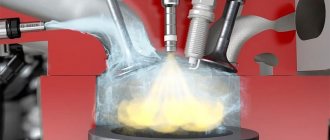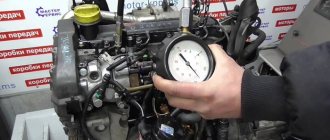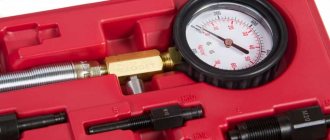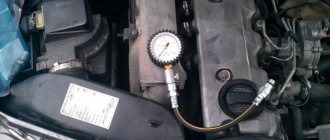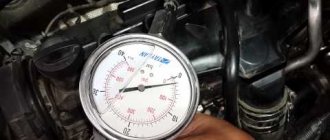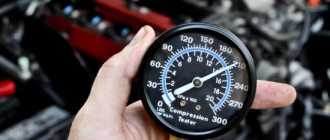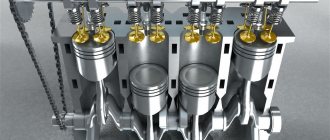Engine compression is familiar to every driver, but some of them still confuse this concept with a compression measure. And indeed, these two technologies are very similar to each other, but they cannot be compared in any way. After all, each part carries its own absolutely exclusive function in the operation of the motor. So, what are the similarities and differences between compression ratio and compression? Let's figure it out.
Definition of compression
To fully understand the meaning of this term, throw aside the automobile reference books. Remember one thing: compression is the greatest pressure inside the cylinder, which occurs only at the end of compression. It is measured in various units of measurement, but most often it is defined in atmospheres. Note that this process is constantly changing due to the degree of engine wear.
The required pressure in the cylinder is individual for each container and depends on its volume. To fully understand the difference between the two concepts above, you just need to look at the following table:
| Motor model | Volume (liters) | Pressure (atmospheres) |
| YaMZ 236 | 11,15 | 24 — 37 |
| EURO-4 | 11,76 | 33 — 39 |
| Lexus ES 300 (used) | 3 | 15 — 16 |
| VAZ 2101 | 1,6 | 10 — 13 |
| D240 | 4, 75 | 25 — 29 |
Possible causes of low blood pressure
We have already said that any compression value directly depends on the condition of the engine. Therefore, we can identify the main reasons for reducing the pressure in the cylinder:
- Mechanical failure of the piston system. It looks like this: small scratches and gouges appear on all parts that come into contact with each other. All this appears due to the use of low-quality and cheap fuel: during the combustion process, sediment is formed, which has a bad effect on the walls of the cylinder and the entire piston as a whole.
- Jamming and jamming of seal rings. Here, too, bad gasoline is behind everything. When burning residues constantly accumulate, the rings become practically glued to the grooves on the rod, and then because of this they cannot unclench when heated. And the result is that the pressure inevitably begins to drop.
- Chips. Since any part of the piston system has its own life, one way or another signs of wear begin to appear. Because of this, small parts slowly fall away from the metal, and this process can lead to both a decrease in pressure in the cylinders and significant damage to the entire engine.
Compression in the internal combustion engine
The obtained indicators when measuring compression are one of the important complex indicators of the state of the CPG (cylinder-piston group) of the internal combustion engine.
If we had an engine with ideal CPG operation, then, theoretically, the compression value would be equal to the quantitative indicator of the compression ratio; in other words, if we compressed the volume of air several times, then the compression value would be the same, but this is only in theory. Since the time allotted for the compression stroke is very small, the compressed air heats up sharply and the pressure on the cylinder walls increases even more, thus, during actual engine operation, the compression exceeds the compression ratio, which has a positive effect on engine operation, the greater the compression value, the better.
During actual engine operation, compression rings become worn out, sticking in the piston bores (coking), ellipse-shaped wear of the cylinder working surface, and microgaps form between the seats and valves through which working gases can leak, which reduces the pressure and the amount of compression, worsening engine performance.
How to increase compression?
To answer this question, it is necessary to discover why there is not enough pressure inside the cylinder-shaped container. Today, you can get rid of the difficulty using several techniques that are applicable depending on the nature of the breakdown. So, the most well-known reason is wear of the cylinder-piston system.
Since such a problem is associated with incomplete pressing of automobile parts, it can only be solved with the help of high technology. The stores offer a wide selection of various additives that will help restore the desired thickness of the worn metal area, which will be absolutely sufficient to achieve the required level of compression. By the way, such additives contain materials that can retain motor oil inside themselves, causing the pressure to become even higher. But this method should be used only if you are absolutely sure of the cause of the breakdown. For example, if you use additives when the piston rings are stuck, then such “treatment” of the car will only worsen the situation. Therefore, be sure to conduct a detailed inspection before repairing. You can read the technical documents of your engine, which will definitely tell you about the optimal compression level. After this, you can safely draw conclusions about the damage.
Now let's talk about piston ring sticking. In this case, use other methods that differ from those presented above. In fact, it is very easy: remove the spark plugs, pour a little motor oil (one hundred grams) into each hole and wait 60 minutes. A fresh oil solution will help soften the accumulated fumes, after which it will completely evaporate every time the engine is started. Are you confident in the compression of your engine? Then compare this indicator with the data obtained after implementing the above process. Now measure the value with a special device, a pressure gauge: if there are no changes, know that the cause is a mechanical failure, so only a specialist from a car repair shop will help you here.
Determining the compression ratio
What does this degree mean? In fact, this is the name given to the ratio of the working volume of the cylinder to the size of the combustion chamber. Note that such a measure always remains unchanged and is not measured in anything, so it would be unreasonable to compare it with compression.
This value directly affects the performance of the engine: the higher the degree of the parameter, the greater will be both the pressure above the piston and the amount of rotation. By the way, if you know the compression ratio, you can easily set the compression size for your engine. To do this, multiply the known figure by 1.4 atmospheres. As a result, you can safely keep in mind the result obtained as the most acceptable measure of pressure.
To calculate the compression ratio we need:
- Measure the working size of the cylinder. To do this, divide the total displacement by the number of cylinders. (If there are 4 of them, and a total of 1100 liters, then the volume will be 275).
- Measure the parameters of the combustion chamber. This should be done while the piston is at its highest point. To make the task easier, use a syringe with motor oil, holding it in place will help you determine the correct number.
- Divide the number you get from the first calculation by the second. The final result will reflect the compression ratio of your engine.
So, we can draw the following conclusion: the two concepts discussed in this article are two completely different processes taking place in a car. If you know these basic definitions, then it will not be difficult for you to determine the cause of your engine failure.
What is engine compression and compression ratio?
Almost every car owner is familiar with the concept of engine compression. But not many people know that there is also a definition of the compression ratio. Motorists may be misled into thinking that these two concepts have things in common, but don't think that's the case. Today we will tell you how these processes differ.
Compression and low pressure prerequisites
Compression
What is compression in relation to an engine? So, compression is the highest degree of pressure that occurs in the cylinder at the end of the compression mechanism. Basically, this force is measured in the number of atmospheres. The amount of pressure required inside the cylinders depends primarily on the engine size.
Prerequisites for low pressure
Pressure, as a variable value, very much depends on what stage of wear the engine is at. The more worn out the engine, the lower the pressure in the cylinders will be. Here are three main reasons for low pressure due to wear:
- The piston system is badly worn. This is characterized by the appearance of micro-scratches and gouges on its elements. One of the reasons is the use of fuel of inadequate quality, when particles of sediment remaining from fuel combustion harm the cylinder walls and piston
- O-rings may become stuck. This happens for the same reason: poor fuel quality. Due to carbon deposits, the sealing rings and piston grooves stick together, which leads to a lack of the required degree of expansion during heating, which in turn leads to a decrease in pressure
- The piston system, like any other vehicle system, wears out over time. As wear occurs, small metal particles are separated from the structure. The consequence is a loss of pressure, as well as other problems with the engine.
How to increase compression?
First of all, it is necessary to understand the true reason for the decrease in pressure. So, if the piston system of a car has worn out, which is accordingly characterized by a decrease in the tightness of the parts between each other, then the way to solve this problem is to purchase the necessary additive to increase the missing thickness of the metal. Which in turn will increase compression. Use this method when you are absolutely sure that this is the problem. You can also find out exactly the proper compression level for your engine in the technical specifications of the car.
If the reason is that the piston rings are jammed, then the sequence of your actions may be as follows: unscrew the spark plugs, pour one hundred grams of oil into the holes and leave the car for about an hour. Oil can soften carbon deposits, which will be removed during subsequent operation of the car. If after all these steps you do not see any changes for the better, then go to the nearest service station for professional diagnostics.
Compression ratio
We found out that compression is the maximum pressure inside the cylinders, and all that remains is to define compression. So, the compression ratio is the ratio between the volume of the entire cylinder and the volume of the combustion chamber. The compression ratio is a constant value that is unique to each brand of car. There is no reason to compare compression and compression ratio, since the latter does not even have units of measurement.
If you know what compression ratio the engine has, you can easily calculate the compression. Simply multiply the compression ratio by 1.4 atmospheres. To determine the compression ratio, do the following:
- Measure the cylinder displacement. This can be done by dividing its total displacement by the number of cylinders
- Measure the dimensions of the combustion chamber. In this case, the piston must be in the upper position. Next, you can use a syringe with machine oil. Record how much oil was poured and get the necessary data
- Divide the two results above between each other to calculate the compression ratio
The conclusion from all of the above will be clear: compression is not equivalent to the compression ratio and it makes no sense to compare these parameters.
